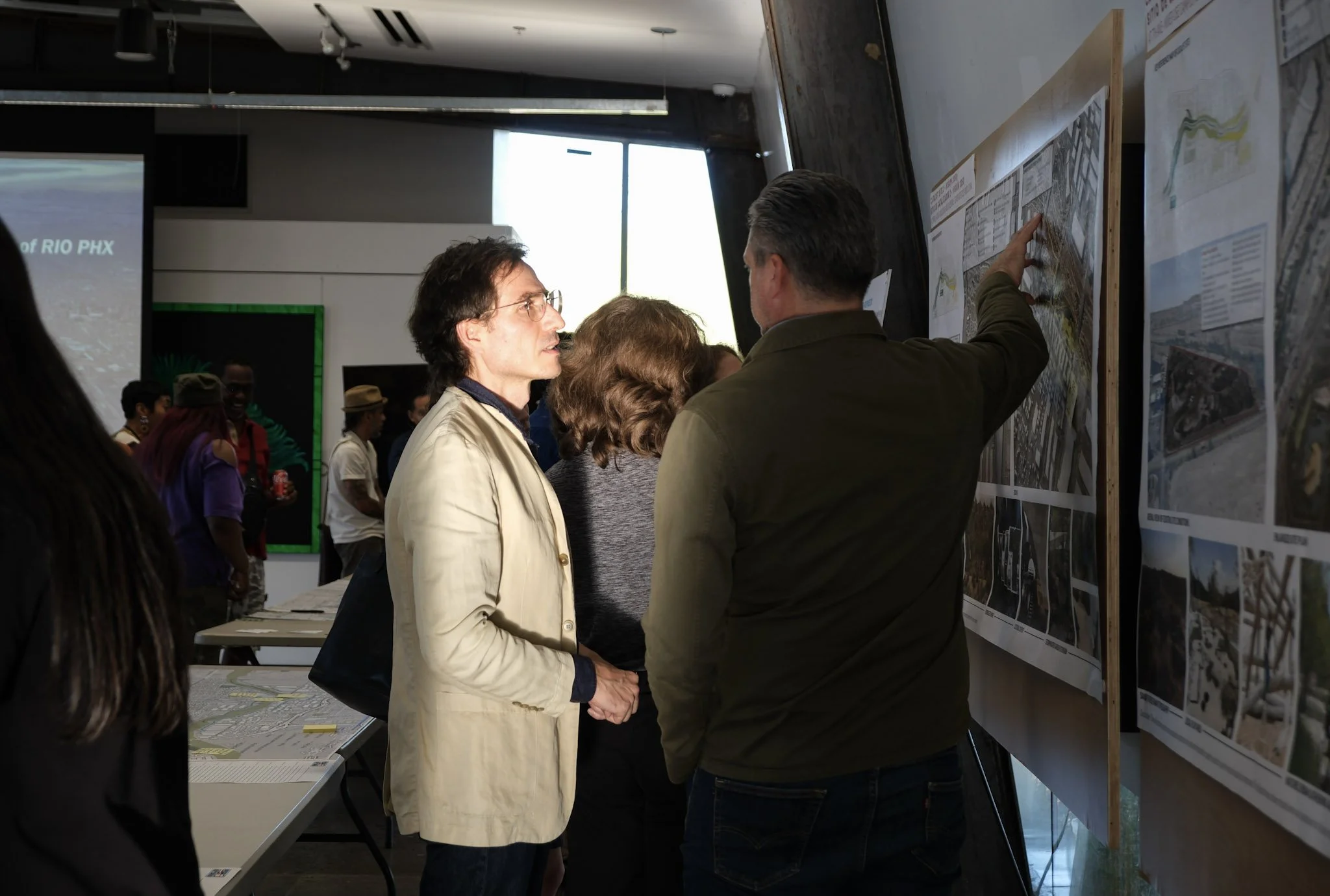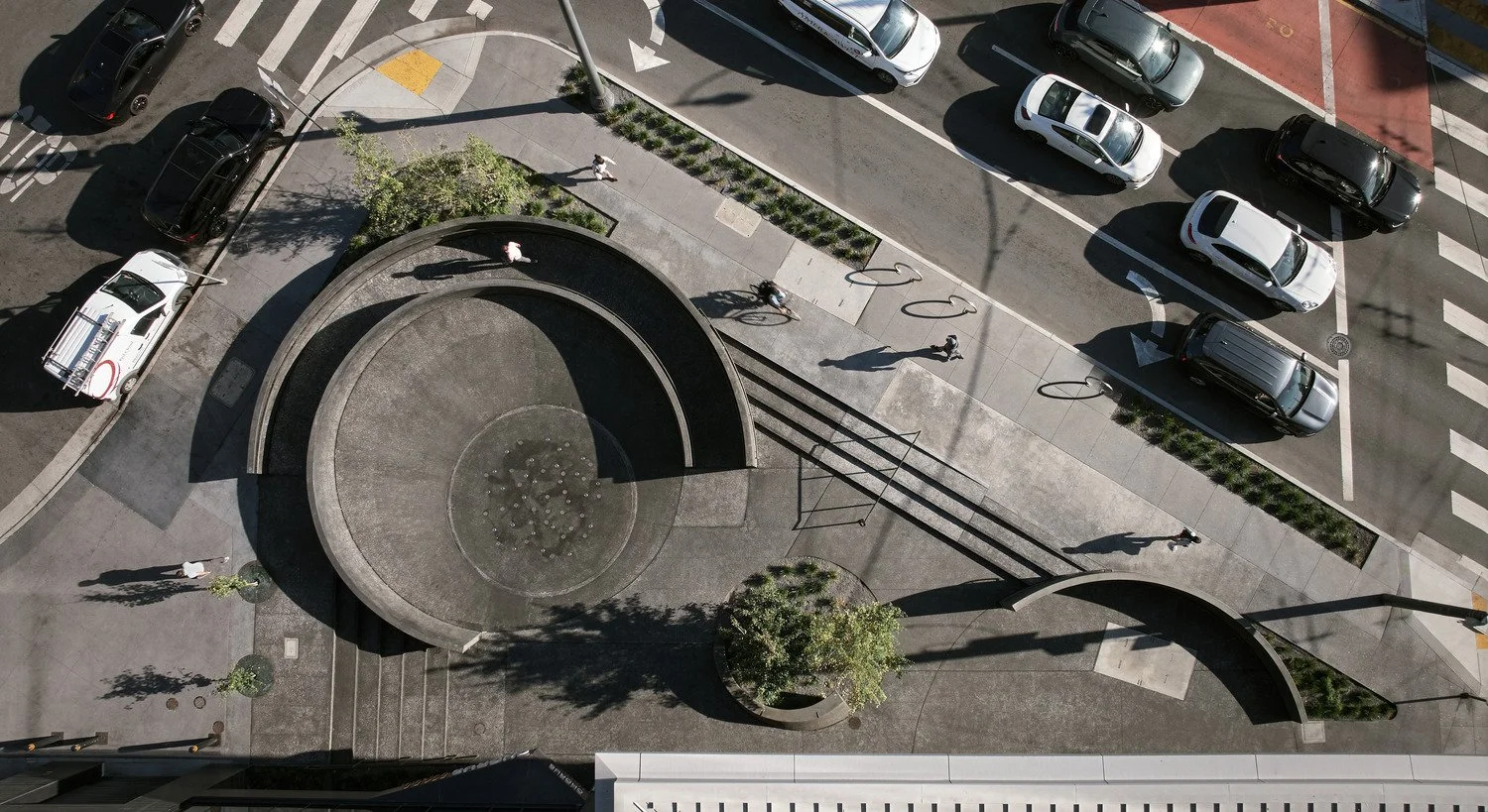A Conversation with Luca Giaramidaro on the Role of Culture and the Public Realm in Shaping San Francisco’s Future
Luca Giaramidaro joined Multistudio in the late summer of 2024 as Vice President and Senior Planner in our San Francisco studio. Trained as an architect in Italy, he holds a doctorate degree in Sustainable Design from Sapienza University of Rome and has spent the past 17 years in the Bay Area working on Urban Regeneration, Transit-Oriented Development, and Transportation.
In July 2025, Luca Giaramidaro led a design collective for the Market Street Reimagined Competition, an international ideas competition organized by Urban Land Institute San Francisco (ULI SF), which was honored with the Award for Place-Making and Connected Neighborhoods. This award is further confirmation of Luca's swift impact at our studio and speaks to his vision for Multistudio’s role as a leader in Urban Development in the Bay Area and beyond.
L to R: Monica Way of Studio-MLA, Daniel Lurie, Mayor of San Francisco, and Luca Giaramidaro
We sat down with Luca to learn more about his recent success, his approach to planning and urban design, and his design philosophy.
Multistudio (M): What drew you to Multistudio?
Luca Giaramidaro (LG): Coming from larger firms, I was drawn to Multistudio’s intimate scale and cross-disciplinary approach. After the pandemic, I took some time back in Italy to reset and reconnect with my roots. When I returned to San Francisco, I wanted to re-engage with my professional network on a more personal level. I already knew Bob Baum (Principal Emeritus) from a previous collaboration, and when we later reconnected, the conversation flowed naturally. Joining Multistudio felt like a great opportunity to break new ground.
M: What do you hope to accomplish?
LG: My role as Vice President at Multistudio is to help grow our Urban Development and City Design practice, positioning the firm as a trusted voice in shaping the Bay Area’s future while also expanding our services firmwide. That means building relationships that matter and advancing projects that shape cities in meaningful ways.
For me, those professional goals align with a personal belief: that culture and the public realm are powerful forces to bring people together, and they are key to rewriting San Francisco’s next chapter as well as the future of many other cities across the United States.
M: In your view, what makes San Francisco a unique place to test new ideas in planning and urban design?
LG: San Francisco has always been a city of transformation. Take the public realm as an example. When I moved here in 2008, I watched the parklet movement take off. What began as a guerrilla-style intervention evolved into an effective solution that responded to people’s desire for a different kind of public space.
In 2020, those interventions became essential strategies for San Francisco’s health and economic resilience. The pandemic shook the city’s soul, and as we now reset its course, it’s clear that we must start by nurturing our sense of community. The city is clear-eyed about the role the public realm must play in that effort. That resonates deeply with me because, in my upbringing, the social dimension of the public realm was always present.
In collaboration with the development team, Frida Escobedo, and Studio Fletcher, we shaped a public realm that fosters civic engagement and quiet reflection within a busy corridor. (Image credit: Multistudio)
It’s also why I see today’s urban challenges not just as infrastructural, but fundamentally cultural. And nowhere is this more visible than downtown, where the lack of a residential community and a slow return to office have left the area without the daily rhythms that once sustained it. The task now is to give people renewed reasons to come back — to spend time there, to connect, and to experience the city again. From street closures to cultural programming, night markets, and festivals, a wave of new initiatives is being tested to draw people back into downtown. In this way, San Francisco remains what it has always been: a living experiment.
M: You recently received the Award for Place-Making and Connected Neighborhoods in the Market Street Reimagined competition from ULI SF. How did you respond to their call for entries to reimagine Market Street’s future in a post-pandemic downtown?
LG: We approached the competition as an opportunity to reframe Market Street not just as a transportation corridor, but as a civic platform for culture and connection. We’re all too familiar with the social media platforms right in our pockets, but plazas and streets are the original physical platforms. Urban spaces are where culture is expressed and community is strengthened — and that idea became the foundation of our submission.
The first step for us was addressing transportation, the backbone of Market Street. We doubled down on a transit-, bicycle-, and pedestrian-first environment, celebrating the historic character of the streetcar while creating a safe and pleasant experience for cyclists and pedestrians. Reducing vehicular lanes allowed for dedicated bike lanes, generous sidewalks, and landscaped pockets that introduce restorative urban ecology. These green pockets weave along the corridor, slowing riding speeds and adding delight to the daily commute, while wider sidewalks provide room for everyday life to spill out and animate the street.
San Francisco’s Living Heart—our winning vision in ULI’s Market Street Reimagined competition—earned the Placemaking & Connectivity award, created with Studio MLA, Systematica, and Vibemap. (Image credit: Multistudio)
Once that linear foundation was set, we turned to Market Street as a system of civic nodes. Running through distinct districts, each with its own history and identity, Market Street offered opportunities to celebrate those layers with spaces that foster belonging, invite social connection, and support spontaneous play and civic gatherings. These nodes emerge where the north–south grids collide, creating irregular intersections and unexpected openings in the urban fabric. Functionally, they may be inefficient for vehicles, but socially, they hold enormous potential. That tension — the irregular, the unplanned, and the serendipitous — is what I’ve continued to explore more broadly in my own work.
M: What does that exploration look like for you?
LG: I’m referring to the exploration of what I call the Urban Theater. An odd intersection becomes a plaza. A sudden shift in the grid reveals a building façade as a backdrop. A leftover space transforms into a stage for gathering. It is in the irregular that we see the potential for the unplanned to happen and for social connections to flourish. Rather than treating these conditions as inefficiencies to be ironed away, I see them as opportunities to be elevated — moments that serve a higher goal than the efficient management of land: the fostering of human connection.
To pursue this kind of investigation, I’ve found it essential to step outside the narrow framework of specialized practice and embrace complexity through a multifaceted lens. The scale and culture of Multistudio enable a closer integration of disciplines — architecture, landscape, urban design, and mobility — each reinforcing the others. It’s an approach that is less bound by specialization and more holistic, which is the perspective I’ve always embraced.
M: How do you translate that kind of holistic exploration into your design process?
LG: Holistic exploration means accepting the unknown — starting with questions rather than preconceived answers. By looking at a problem from multiple angles, across disciplines, we allow unexpected relationships to emerge and even surprise us.
That explorative mindset, for me, is much like doodling: testing possibilities without the pressure of being right, playfully. Play is where we stop taking ourselves too seriously and give ourselves the freedom to let sensitivity lead. In other words, it’s about putting your antenna up and process conditions, opportunities, and aspirations in a sensitive way.
My work often begins with a gut feeling, something that surfaces almost unconsciously. The key is to let that intuition take shape, then crystallize it through the rigor of science.
M: What are you most looking forward to as you continue to experiment at Multistudio?
LG: For me, experimentation means embracing uncertainty. You need to get lost before you can find anything new. Cities are like that — the tighter and more efficient the structure, the more predetermined the outcomes. But when there’s room for openness and exploration, unexpected connections emerge.
Today’s complexities call for a renewed paradigm in the way we practice — one that focuses as much on human experience as it does on technical performance. As architects, we need now more than ever to exercise both the rigor of science and the uplifting power of art — and in that balance is where architecture can truly be of service.
I see that potential at Multistudio right now. The leaders who built this practice are beginning to pass the torch, and it feels like a moment of reinvention — a chance to define new frames of reference for the world we co-create. For me, that’s incredibly exciting.
The City of Phoenix 2050 Community Vision Plan, developed by Multistudio, SCAPE, and the City, outlines a vision for 7 square miles along the Rio Salado. (Image credit: Multistudio)
This article was originally posted on Multistudio




